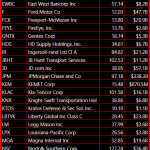
The main driver of the investment climate is not so much the incremental economic data as the capital markets themselves. The market turmoil contributed to the tightening of financial conditions, which in turn heightened risks, which monetary officials are committed to resisting.
Financial markets stabilized last week, but the tone remains fragile. The damage to the technical condition and sentiment requires further consolidation to rebuild investor confidence.
The price action should not detract from the underlying signal, which is characterized by the divergence of economic and monetary policy among the high income countries. Comments by a number of Fed officials, and in particular the leadership, seem to make two key points. First, prudence suggests the bar to a follow-up rate hike in three weeks is sufficiently high to make it unlikely. Second, the gradual normalization of monetary policy remains intact.
The erosion of both market and survey-based measures of inflation expectations have deteriorated. This alone justifies a cautious approach. Actual core inflation measures remain firm.Core CPI rose in January to new three-year highs. The core PCE deflator, the Fed’s preferred measure, will be reported in the week ahead, and is also expected to have ticked up.
The US economy practically stagnated in Q4 15, but the prospects have improved markedly despite the market turbulence. The wealth effect associated with the precipitous decline in equity prices did not curtail American shopping, and that is also likely to be borne out with the January personal consumption expenditures that will be reported next week.
The increase in jobs and wages is fueling household consumption, not revolving credit. Consumption rose 3.1% in 2015, the strongest in a decade.It appears to be tracking close to 3% at an annualized rate now.Improvement in industrial output and manufacturing will likely be joined by an increase in durable goods orders that will be reported in the new week.
The pessimists are leaning the wrong way. Far from being a harbinger of a recession as many warned, the disappointing economic performance at the end of last year was part of the volatility of quarterly GDP figures that may also be part of the “new normal.” Activity in Q1 16 is re-accelerating, and the economy appears to be tracking growth somewhat above trend.
If the Federal Reserve’s forecasts for four rate hikes for this year was exaggerated, so too is the market’s refusal to discount a single move fully. Barring a new negative shock, we expect the Fed to deliver the second hike in the cycle in June. This is reminiscent of what happened in 2015 when the Fed was dissuaded from hiking rates in September due to falling inflation expectations and market turbulence, but delivered in December. Tactical flexibility need not undermine strategic commitments.













Leave A Comment